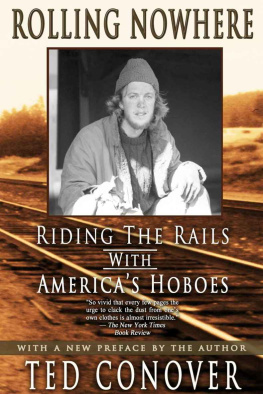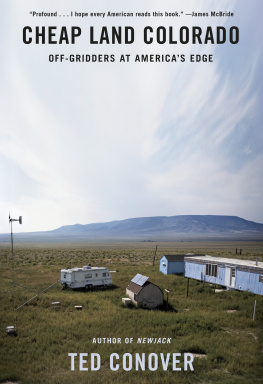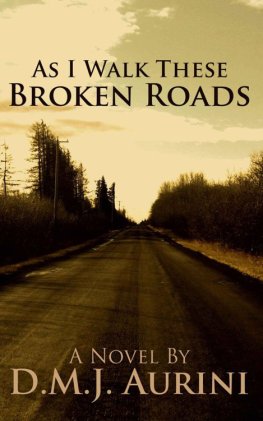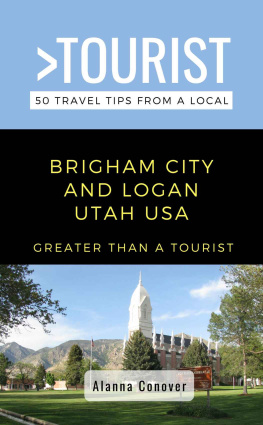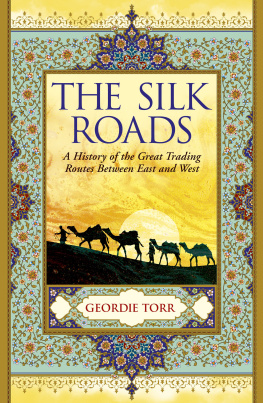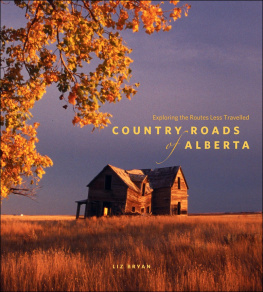Ted Conover - The Routes of Man: How Roads Are Changing the World and the Way We Live Today
Here you can read online Ted Conover - The Routes of Man: How Roads Are Changing the World and the Way We Live Today full text of the book (entire story) in english for free. Download pdf and epub, get meaning, cover and reviews about this ebook. publisher: Knopf Doubleday Publishing Group, genre: Detective and thriller. Description of the work, (preface) as well as reviews are available. Best literature library LitArk.com created for fans of good reading and offers a wide selection of genres:
Romance novel
Science fiction
Adventure
Detective
Science
History
Home and family
Prose
Art
Politics
Computer
Non-fiction
Religion
Business
Children
Humor
Choose a favorite category and find really read worthwhile books. Enjoy immersion in the world of imagination, feel the emotions of the characters or learn something new for yourself, make an fascinating discovery.

- Book:The Routes of Man: How Roads Are Changing the World and the Way We Live Today
- Author:
- Publisher:Knopf Doubleday Publishing Group
- Genre:
- Rating:5 / 5
- Favourites:Add to favourites
- Your mark:
- 100
- 1
- 2
- 3
- 4
- 5
The Routes of Man: How Roads Are Changing the World and the Way We Live Today: summary, description and annotation
We offer to read an annotation, description, summary or preface (depends on what the author of the book "The Routes of Man: How Roads Are Changing the World and the Way We Live Today" wrote himself). If you haven't found the necessary information about the book — write in the comments, we will try to find it.
The Routes of Man: How Roads Are Changing the World and the Way We Live Today — read online for free the complete book (whole text) full work
Below is the text of the book, divided by pages. System saving the place of the last page read, allows you to conveniently read the book "The Routes of Man: How Roads Are Changing the World and the Way We Live Today" online for free, without having to search again every time where you left off. Put a bookmark, and you can go to the page where you finished reading at any time.
Font size:
Interval:
Bookmark:
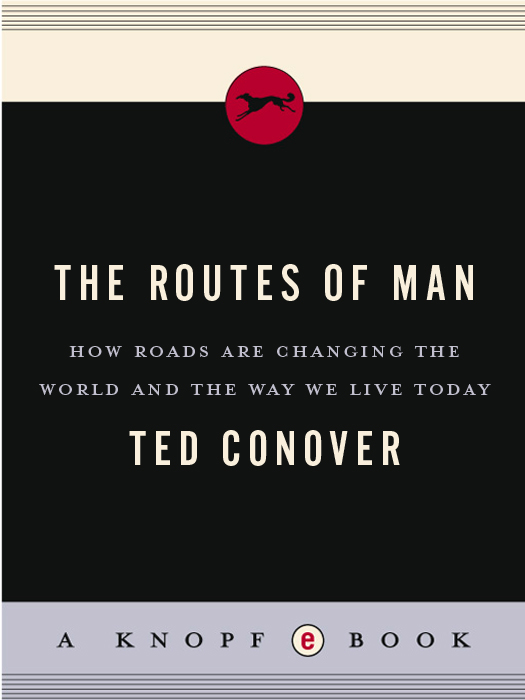
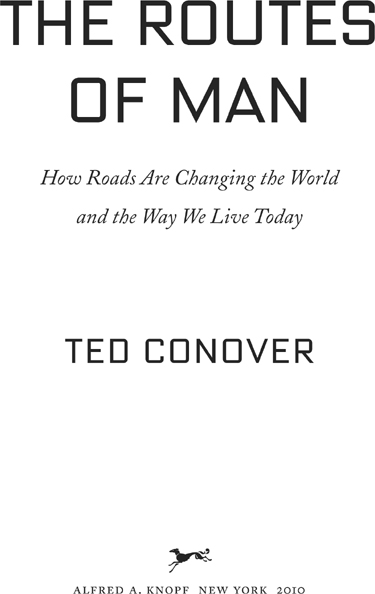
ALSO BY TED CONOVER
Newjack:
Guarding Sing Sing
Whiteout:
Lost in Aspen
Coyotes:
A Journey Across Borders with Americas Mexican Migrants
Rolling Nowhere:
Riding the Rails with Americas Hoboes
TO JAY LEIBOLD
I began to see how the road altered not only the way people travelled, but how they perceived the world.
J. B. Jackson,
The Necessity for Ruins
One:
Two:
Three:
Four:
Five:
Six:
He used often to say there was only one Road; that it was like a great river: its springs were at every doorstep and every path was its tributary. Its a dangerous business, Frodo, going out of your door, he used to say. You step into the Road, and if you dont keep your feet, there is no telling where you might be swept off to.
Frodo Baggins of his uncle, Bilbo,
in J. R. R. Tolkiens The Fellowship of the Ring
(The Lord of the Rings, Book One)
EVERY ROAD IS A STORY OF STRIVING : for profit, for victory in battle, for discovery and adventure, for survival and growth, or simply for livability. Each path reflects our desire to move and connect. Anyone who has benefited from a better roada shorter route, a smoother and safer drivecan testify to the importance of good roads. But when humans strive, we also err, and it is hard to build without destroying. Robert Moses, the controversial creator of highways around New York City in the middle of the twentieth century, wiped out numerous neighborhoods with his projects, turning vibrant communities (notably the South Bronx) into wastelands that have yet to recover. Of his actions he famously said, In order to make an omelet, youve got to break a few eggs. In a related way, the same roads that carry medicine also hasten the spread of deadly disease; the same roads that bring outside connection and knowledge to people starving for them sometimes spell the end of indigenous cultures; the same roads that help develop the human economy open the way for destruction of the non-human environment; the same roads that carry cars symbolizing personal freedom are the setting for the deaths of more people than die in wars, and of untold numbers of animals; and the same roads that introduce us to friends also provide access to enemies.
In this book I present six of these roads that are reshaping the world. I do it by joining up with people on themtravelers to whom they matter in an immediate and practical way. The roads are presented roughly in order of increasing complexity, which is also the intentional order in which I traveled them over the past several years. Each has a theme: development vs. the environment, isolation vs. progress, military occupation, transmission of disease, social transformation, and the future of the city. Not each of the chapters is about a single road, precisely; one tells about a trip on a series of roads in China, and another about roads and streets in Lagos, Nigeria. Each is a story and a meditation.
We in the twenty-first century are more numerous and better connected than people at any previous time in history. Networks are a principal theme of our age, and as the networks we are a part of continue to grow, we struggle to understand what that connectedness means. Not all connections are good. We save hours or days when we fly; yet it was the globe-hopping of a single promiscuous flight attendant that got the AIDS epidemic off to a fast start. We are threatened by terrorist networks such as Al Qaeda. The complex integration of the electric power grid, in North America as well as other parts of the world, means that a failure in suburban Ohio can black out large sections of the Northeast, the Midwest, and Canada, as happened in 2003. Politics and financial markets in one corner of the globe can affect financial markets everywhere. On a small scale, this means that a rebel attack on a Nigerian oil pipeline can cause a spike in world prices that will be reflected at the pump within days. Writ large, this means that a mortgage crisis in the United States can devastate financial markets around the world. Connection means vulnerability.
But most of our networks, most of the time, appear to advance human progress, leading to greater efficiencies and broader knowledge. We realize, for example, that we are part of social networks that extend far beyond our immediate circle of friends. (John Guares play Six Degrees of Separation popularized the notion that everybody on the planet is connected to everyone else through a maximum of six intermediaries.) The extension of social worlds beyond a network of local friends is greatly abetted by electronic communications networkswired and, increasingly, mobile telephones and text messages, and, most transformative of
Have electronic communications rendered road networks less important? Hardly. Our inner circle of friends, our home communities, are still connected by roads. Everything real, by which I mean everything nonvirtualfood, furniture, goods of every description (including computers, I should add)might be ordered online but they actually arrive overland, by train or plane, perhaps, for some of their journey, but always substantially by road. (The bumper sticker you see on trucks reminds us: If youve got it, a trucker brought it.) Roads remain the essential network of the non-virtual world. They are the infrastructure upon which almost all other infrastructure depends. They are the paths of human endeavor.
Roads have probably always played a role in the shaping of human settlement, but it was the Romans who first demonstrated what a large network of roads could do. The Appian Way was only the most famous road leading out of Rome; eighteen others did as well, part of a system that, at its peak, extended 53,000 miles. The Roman roadsand the empireextended as far as the British Isles, over the Alps to Spain and central and eastern Europe, east to present-day Greece and Turkey, and through the Holy Land, all the way around the Mediterranean, including North Africa.
Constructed over eight hundred years, they allowed for the movement of armies and the expansion of empire. Roman roads were nonpareil. Soldiersroads were built by the militarydug a deep bed and then filled it with layers of gravel or other rocks, depending on the location. Principal routes were paved with cut stones that fit together with mosaic tightness; their bottom surfaces, sunk into the substrate, were diamond-shaped. The road was camberedhigher in the middle and gently sloping to the sidesto allow for drainage, and drainage ditches along the side were a common feature. So well were Roman roads made that many still exist. The empires most enduring monuments, some rutted with the tracks of hundreds of years of wagon wheels, these remnants run alongside ruins of inns or barracks, and parallel or undergird modern roads.
As the Roman Empire grew weak, the Janus-headed nature of the network became clear. The advantage of the road could be a drawback: barbarian tribes began making use of Romes own roads to attack the empire. Armies of Ostrogoths, Visigoths, and Vandals, Germanic tribes once in the Roman service, rebelled. Alaric, the Visigoth king, first attacked Constantinople and next Italy, around A.D . 400; Rome finally capitulated after a blockade of roads around it in 408 threatened citizens with mass starvation. The fine roads were instrumental in effectively ending the Western Roman Empire.
Font size:
Interval:
Bookmark:
Similar books «The Routes of Man: How Roads Are Changing the World and the Way We Live Today»
Look at similar books to The Routes of Man: How Roads Are Changing the World and the Way We Live Today. We have selected literature similar in name and meaning in the hope of providing readers with more options to find new, interesting, not yet read works.
Discussion, reviews of the book The Routes of Man: How Roads Are Changing the World and the Way We Live Today and just readers' own opinions. Leave your comments, write what you think about the work, its meaning or the main characters. Specify what exactly you liked and what you didn't like, and why you think so.

